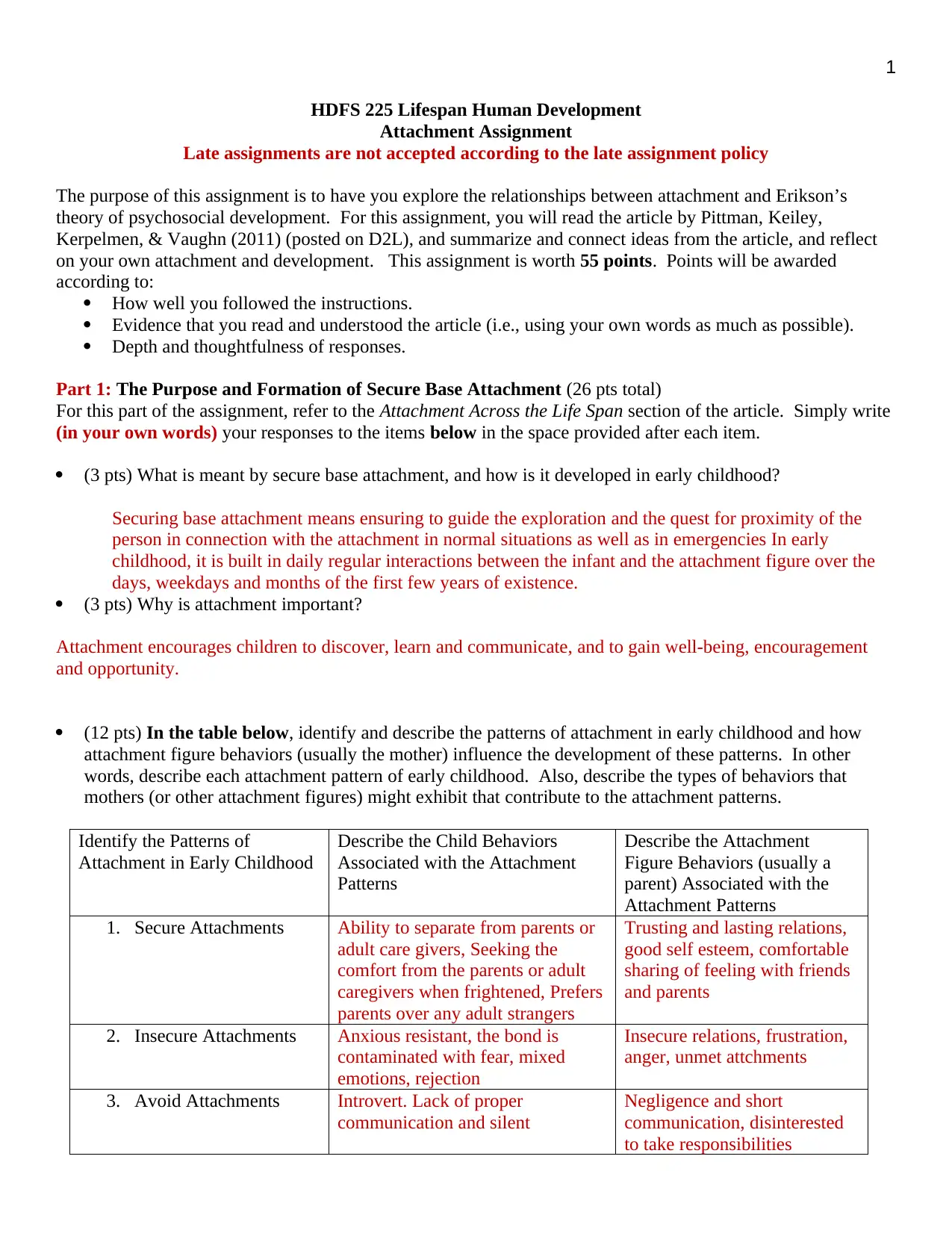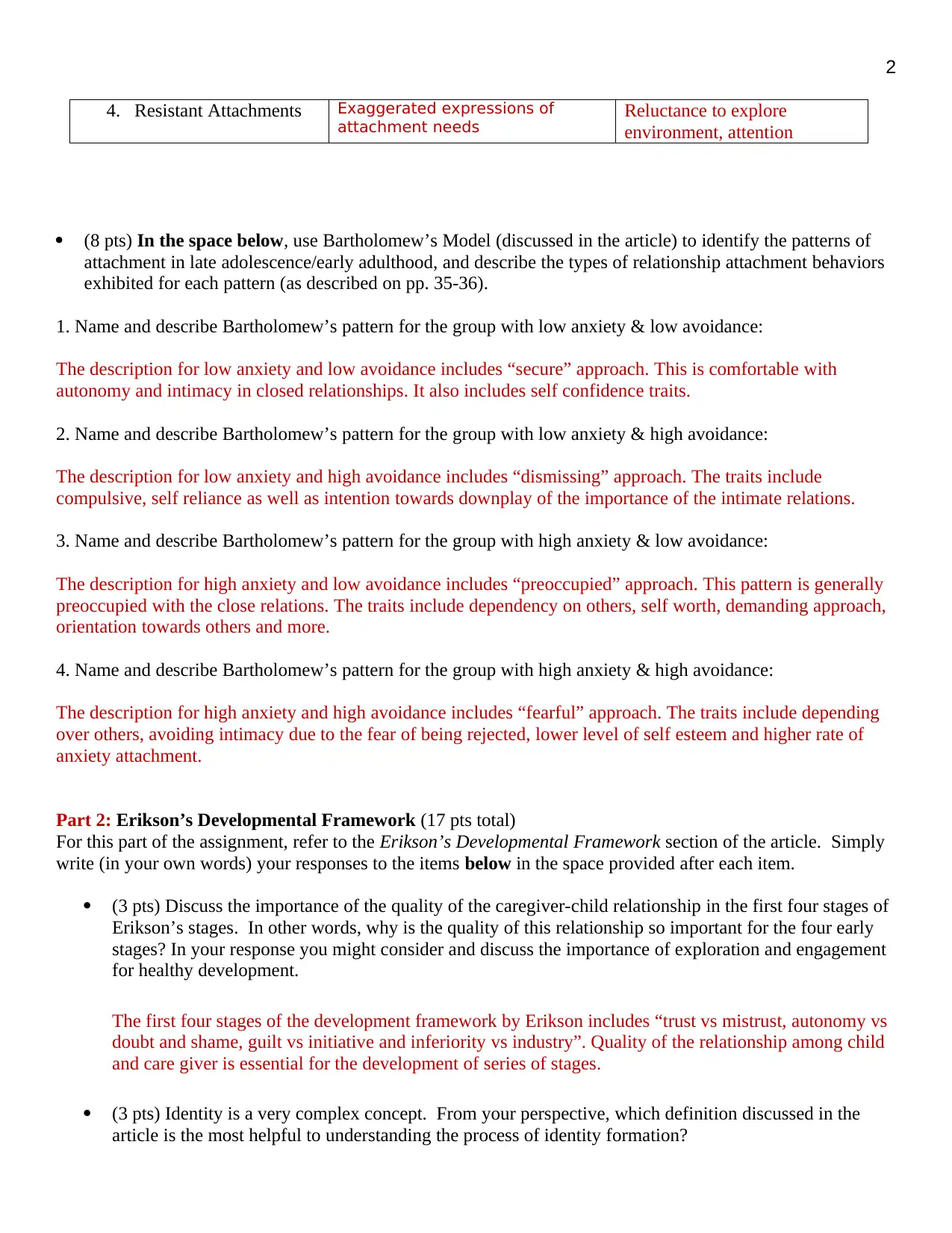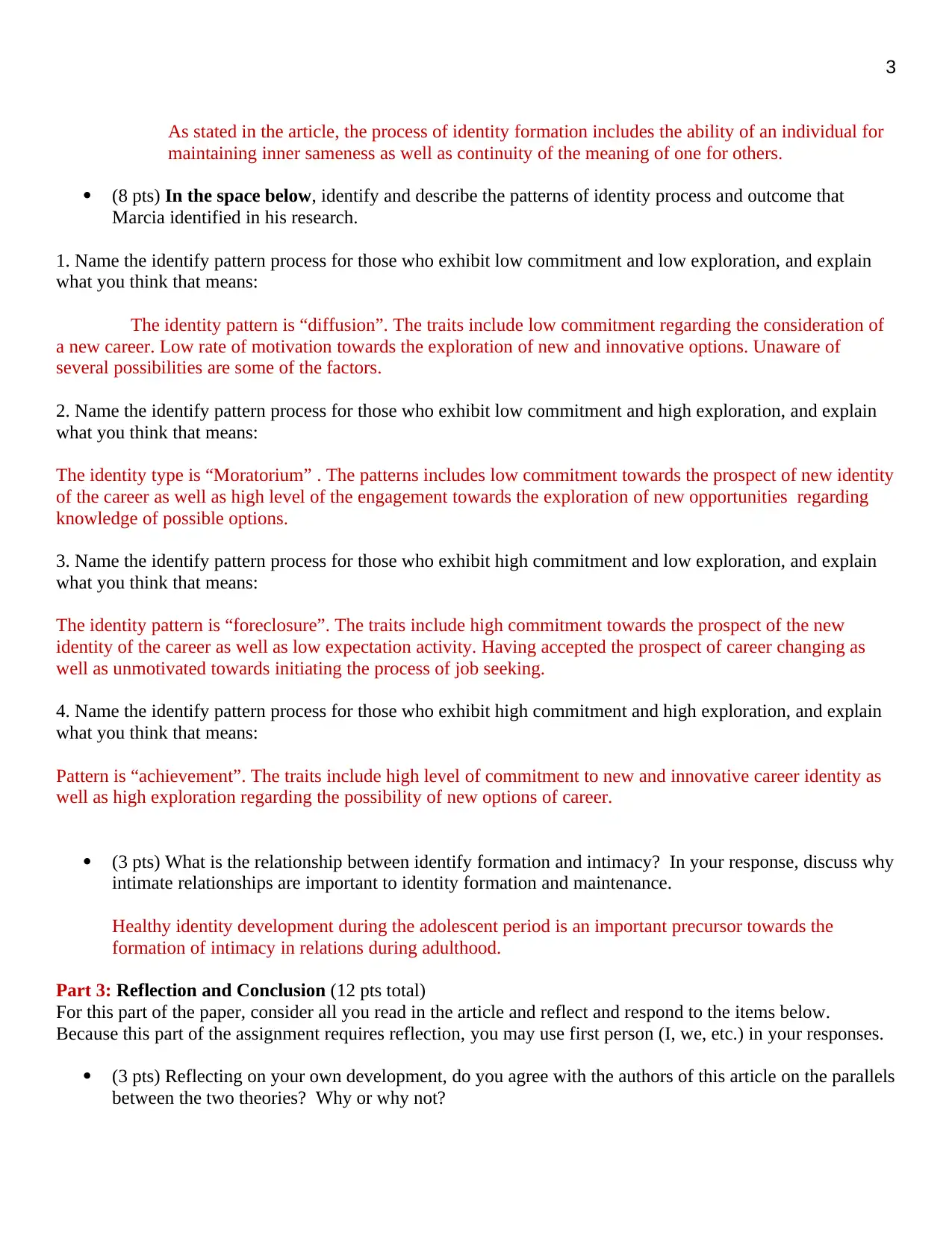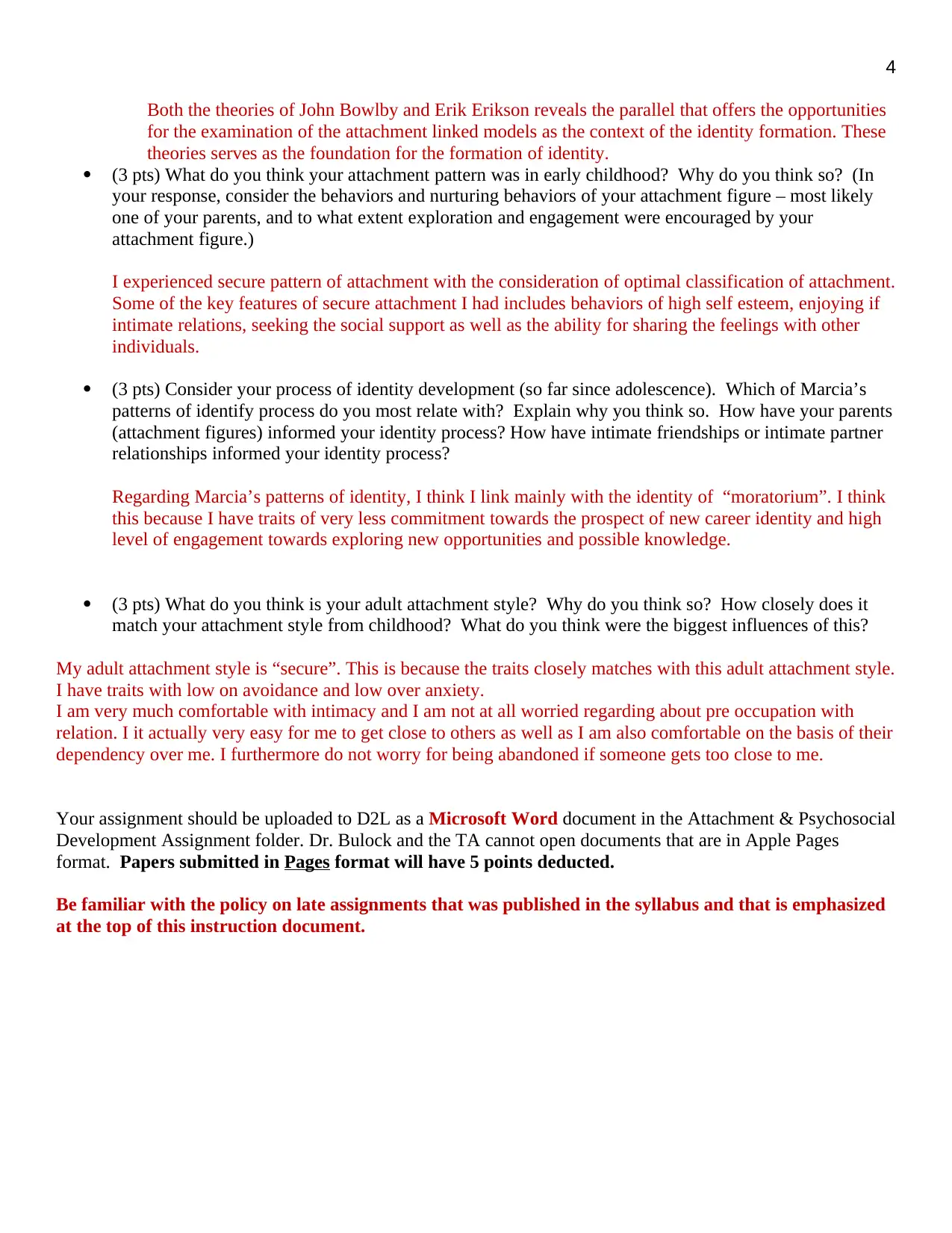Attachment, Erikson, and Development Assignment: HDFS 225, Fall 2024
VerifiedAdded on 2022/08/22
|5
|2003
|16
Homework Assignment
AI Summary
This assignment, for HDFS 225, explores the intersection of attachment theory and Erikson's theory of psychosocial development, drawing from the article by Pittman, Keiley, Kerpelmen, & Vaughn (2011). The assignment is divided into three parts. Part 1 focuses on secure base attachment, attachment patterns in early childhood (secure, insecure, avoidant, and resistant), and Bartholomew's model of attachment in late adolescence/early adulthood. Part 2 examines Erikson's developmental framework, including the importance of caregiver-child relationships and Marcia's patterns of identity process and outcome (diffusion, moratorium, foreclosure, and achievement). Part 3 requires reflection on personal attachment styles, identity development, and the parallels between the two theories. The student discusses their own attachment history, identity formation, and how these relate to the theories presented in the article. The assignment aims to connect theoretical concepts with personal experiences and developmental processes.

1
HDFS 225 Lifespan Human Development
Attachment Assignment
Late assignments are not accepted according to the late assignment policy
The purpose of this assignment is to have you explore the relationships between attachment and Erikson’s
theory of psychosocial development. For this assignment, you will read the article by Pittman, Keiley,
Kerpelmen, & Vaughn (2011) (posted on D2L), and summarize and connect ideas from the article, and reflect
on your own attachment and development. This assignment is worth 55 points. Points will be awarded
according to:
How well you followed the instructions.
Evidence that you read and understood the article (i.e., using your own words as much as possible).
Depth and thoughtfulness of responses.
Part 1: The Purpose and Formation of Secure Base Attachment (26 pts total)
For this part of the assignment, refer to the Attachment Across the Life Span section of the article. Simply write
(in your own words) your responses to the items below in the space provided after each item.
(3 pts) What is meant by secure base attachment, and how is it developed in early childhood?
Securing base attachment means ensuring to guide the exploration and the quest for proximity of the
person in connection with the attachment in normal situations as well as in emergencies In early
childhood, it is built in daily regular interactions between the infant and the attachment figure over the
days, weekdays and months of the first few years of existence.
(3 pts) Why is attachment important?
Attachment encourages children to discover, learn and communicate, and to gain well-being, encouragement
and opportunity.
(12 pts) In the table below, identify and describe the patterns of attachment in early childhood and how
attachment figure behaviors (usually the mother) influence the development of these patterns. In other
words, describe each attachment pattern of early childhood. Also, describe the types of behaviors that
mothers (or other attachment figures) might exhibit that contribute to the attachment patterns.
Identify the Patterns of
Attachment in Early Childhood
Describe the Child Behaviors
Associated with the Attachment
Patterns
Describe the Attachment
Figure Behaviors (usually a
parent) Associated with the
Attachment Patterns
1. Secure Attachments Ability to separate from parents or
adult care givers, Seeking the
comfort from the parents or adult
caregivers when frightened, Prefers
parents over any adult strangers
Trusting and lasting relations,
good self esteem, comfortable
sharing of feeling with friends
and parents
2. Insecure Attachments Anxious resistant, the bond is
contaminated with fear, mixed
emotions, rejection
Insecure relations, frustration,
anger, unmet attchments
3. Avoid Attachments Introvert. Lack of proper
communication and silent
Negligence and short
communication, disinterested
to take responsibilities
HDFS 225 Lifespan Human Development
Attachment Assignment
Late assignments are not accepted according to the late assignment policy
The purpose of this assignment is to have you explore the relationships between attachment and Erikson’s
theory of psychosocial development. For this assignment, you will read the article by Pittman, Keiley,
Kerpelmen, & Vaughn (2011) (posted on D2L), and summarize and connect ideas from the article, and reflect
on your own attachment and development. This assignment is worth 55 points. Points will be awarded
according to:
How well you followed the instructions.
Evidence that you read and understood the article (i.e., using your own words as much as possible).
Depth and thoughtfulness of responses.
Part 1: The Purpose and Formation of Secure Base Attachment (26 pts total)
For this part of the assignment, refer to the Attachment Across the Life Span section of the article. Simply write
(in your own words) your responses to the items below in the space provided after each item.
(3 pts) What is meant by secure base attachment, and how is it developed in early childhood?
Securing base attachment means ensuring to guide the exploration and the quest for proximity of the
person in connection with the attachment in normal situations as well as in emergencies In early
childhood, it is built in daily regular interactions between the infant and the attachment figure over the
days, weekdays and months of the first few years of existence.
(3 pts) Why is attachment important?
Attachment encourages children to discover, learn and communicate, and to gain well-being, encouragement
and opportunity.
(12 pts) In the table below, identify and describe the patterns of attachment in early childhood and how
attachment figure behaviors (usually the mother) influence the development of these patterns. In other
words, describe each attachment pattern of early childhood. Also, describe the types of behaviors that
mothers (or other attachment figures) might exhibit that contribute to the attachment patterns.
Identify the Patterns of
Attachment in Early Childhood
Describe the Child Behaviors
Associated with the Attachment
Patterns
Describe the Attachment
Figure Behaviors (usually a
parent) Associated with the
Attachment Patterns
1. Secure Attachments Ability to separate from parents or
adult care givers, Seeking the
comfort from the parents or adult
caregivers when frightened, Prefers
parents over any adult strangers
Trusting and lasting relations,
good self esteem, comfortable
sharing of feeling with friends
and parents
2. Insecure Attachments Anxious resistant, the bond is
contaminated with fear, mixed
emotions, rejection
Insecure relations, frustration,
anger, unmet attchments
3. Avoid Attachments Introvert. Lack of proper
communication and silent
Negligence and short
communication, disinterested
to take responsibilities
Paraphrase This Document
Need a fresh take? Get an instant paraphrase of this document with our AI Paraphraser

2
4. Resistant Attachments Exaggerated expressions of
attachment needs Reluctance to explore
environment, attention
(8 pts) In the space below, use Bartholomew’s Model (discussed in the article) to identify the patterns of
attachment in late adolescence/early adulthood, and describe the types of relationship attachment behaviors
exhibited for each pattern (as described on pp. 35-36).
1. Name and describe Bartholomew’s pattern for the group with low anxiety & low avoidance:
The description for low anxiety and low avoidance includes “secure” approach. This is comfortable with
autonomy and intimacy in closed relationships. It also includes self confidence traits.
2. Name and describe Bartholomew’s pattern for the group with low anxiety & high avoidance:
The description for low anxiety and high avoidance includes “dismissing” approach. The traits include
compulsive, self reliance as well as intention towards downplay of the importance of the intimate relations.
3. Name and describe Bartholomew’s pattern for the group with high anxiety & low avoidance:
The description for high anxiety and low avoidance includes “preoccupied” approach. This pattern is generally
preoccupied with the close relations. The traits include dependency on others, self worth, demanding approach,
orientation towards others and more.
4. Name and describe Bartholomew’s pattern for the group with high anxiety & high avoidance:
The description for high anxiety and high avoidance includes “fearful” approach. The traits include depending
over others, avoiding intimacy due to the fear of being rejected, lower level of self esteem and higher rate of
anxiety attachment.
Part 2: Erikson’s Developmental Framework (17 pts total)
For this part of the assignment, refer to the Erikson’s Developmental Framework section of the article. Simply
write (in your own words) your responses to the items below in the space provided after each item.
(3 pts) Discuss the importance of the quality of the caregiver-child relationship in the first four stages of
Erikson’s stages. In other words, why is the quality of this relationship so important for the four early
stages? In your response you might consider and discuss the importance of exploration and engagement
for healthy development.
The first four stages of the development framework by Erikson includes “trust vs mistrust, autonomy vs
doubt and shame, guilt vs initiative and inferiority vs industry”. Quality of the relationship among child
and care giver is essential for the development of series of stages.
(3 pts) Identity is a very complex concept. From your perspective, which definition discussed in the
article is the most helpful to understanding the process of identity formation?
4. Resistant Attachments Exaggerated expressions of
attachment needs Reluctance to explore
environment, attention
(8 pts) In the space below, use Bartholomew’s Model (discussed in the article) to identify the patterns of
attachment in late adolescence/early adulthood, and describe the types of relationship attachment behaviors
exhibited for each pattern (as described on pp. 35-36).
1. Name and describe Bartholomew’s pattern for the group with low anxiety & low avoidance:
The description for low anxiety and low avoidance includes “secure” approach. This is comfortable with
autonomy and intimacy in closed relationships. It also includes self confidence traits.
2. Name and describe Bartholomew’s pattern for the group with low anxiety & high avoidance:
The description for low anxiety and high avoidance includes “dismissing” approach. The traits include
compulsive, self reliance as well as intention towards downplay of the importance of the intimate relations.
3. Name and describe Bartholomew’s pattern for the group with high anxiety & low avoidance:
The description for high anxiety and low avoidance includes “preoccupied” approach. This pattern is generally
preoccupied with the close relations. The traits include dependency on others, self worth, demanding approach,
orientation towards others and more.
4. Name and describe Bartholomew’s pattern for the group with high anxiety & high avoidance:
The description for high anxiety and high avoidance includes “fearful” approach. The traits include depending
over others, avoiding intimacy due to the fear of being rejected, lower level of self esteem and higher rate of
anxiety attachment.
Part 2: Erikson’s Developmental Framework (17 pts total)
For this part of the assignment, refer to the Erikson’s Developmental Framework section of the article. Simply
write (in your own words) your responses to the items below in the space provided after each item.
(3 pts) Discuss the importance of the quality of the caregiver-child relationship in the first four stages of
Erikson’s stages. In other words, why is the quality of this relationship so important for the four early
stages? In your response you might consider and discuss the importance of exploration and engagement
for healthy development.
The first four stages of the development framework by Erikson includes “trust vs mistrust, autonomy vs
doubt and shame, guilt vs initiative and inferiority vs industry”. Quality of the relationship among child
and care giver is essential for the development of series of stages.
(3 pts) Identity is a very complex concept. From your perspective, which definition discussed in the
article is the most helpful to understanding the process of identity formation?

3
As stated in the article, the process of identity formation includes the ability of an individual for
maintaining inner sameness as well as continuity of the meaning of one for others.
(8 pts) In the space below, identify and describe the patterns of identity process and outcome that
Marcia identified in his research.
1. Name the identify pattern process for those who exhibit low commitment and low exploration, and explain
what you think that means:
The identity pattern is “diffusion”. The traits include low commitment regarding the consideration of
a new career. Low rate of motivation towards the exploration of new and innovative options. Unaware of
several possibilities are some of the factors.
2. Name the identify pattern process for those who exhibit low commitment and high exploration, and explain
what you think that means:
The identity type is “Moratorium” . The patterns includes low commitment towards the prospect of new identity
of the career as well as high level of the engagement towards the exploration of new opportunities regarding
knowledge of possible options.
3. Name the identify pattern process for those who exhibit high commitment and low exploration, and explain
what you think that means:
The identity pattern is “foreclosure”. The traits include high commitment towards the prospect of the new
identity of the career as well as low expectation activity. Having accepted the prospect of career changing as
well as unmotivated towards initiating the process of job seeking.
4. Name the identify pattern process for those who exhibit high commitment and high exploration, and explain
what you think that means:
Pattern is “achievement”. The traits include high level of commitment to new and innovative career identity as
well as high exploration regarding the possibility of new options of career.
(3 pts) What is the relationship between identify formation and intimacy? In your response, discuss why
intimate relationships are important to identity formation and maintenance.
Healthy identity development during the adolescent period is an important precursor towards the
formation of intimacy in relations during adulthood.
Part 3: Reflection and Conclusion (12 pts total)
For this part of the paper, consider all you read in the article and reflect and respond to the items below.
Because this part of the assignment requires reflection, you may use first person (I, we, etc.) in your responses.
(3 pts) Reflecting on your own development, do you agree with the authors of this article on the parallels
between the two theories? Why or why not?
As stated in the article, the process of identity formation includes the ability of an individual for
maintaining inner sameness as well as continuity of the meaning of one for others.
(8 pts) In the space below, identify and describe the patterns of identity process and outcome that
Marcia identified in his research.
1. Name the identify pattern process for those who exhibit low commitment and low exploration, and explain
what you think that means:
The identity pattern is “diffusion”. The traits include low commitment regarding the consideration of
a new career. Low rate of motivation towards the exploration of new and innovative options. Unaware of
several possibilities are some of the factors.
2. Name the identify pattern process for those who exhibit low commitment and high exploration, and explain
what you think that means:
The identity type is “Moratorium” . The patterns includes low commitment towards the prospect of new identity
of the career as well as high level of the engagement towards the exploration of new opportunities regarding
knowledge of possible options.
3. Name the identify pattern process for those who exhibit high commitment and low exploration, and explain
what you think that means:
The identity pattern is “foreclosure”. The traits include high commitment towards the prospect of the new
identity of the career as well as low expectation activity. Having accepted the prospect of career changing as
well as unmotivated towards initiating the process of job seeking.
4. Name the identify pattern process for those who exhibit high commitment and high exploration, and explain
what you think that means:
Pattern is “achievement”. The traits include high level of commitment to new and innovative career identity as
well as high exploration regarding the possibility of new options of career.
(3 pts) What is the relationship between identify formation and intimacy? In your response, discuss why
intimate relationships are important to identity formation and maintenance.
Healthy identity development during the adolescent period is an important precursor towards the
formation of intimacy in relations during adulthood.
Part 3: Reflection and Conclusion (12 pts total)
For this part of the paper, consider all you read in the article and reflect and respond to the items below.
Because this part of the assignment requires reflection, you may use first person (I, we, etc.) in your responses.
(3 pts) Reflecting on your own development, do you agree with the authors of this article on the parallels
between the two theories? Why or why not?
⊘ This is a preview!⊘
Do you want full access?
Subscribe today to unlock all pages.

Trusted by 1+ million students worldwide

4
Both the theories of John Bowlby and Erik Erikson reveals the parallel that offers the opportunities
for the examination of the attachment linked models as the context of the identity formation. These
theories serves as the foundation for the formation of identity.
(3 pts) What do you think your attachment pattern was in early childhood? Why do you think so? (In
your response, consider the behaviors and nurturing behaviors of your attachment figure – most likely
one of your parents, and to what extent exploration and engagement were encouraged by your
attachment figure.)
I experienced secure pattern of attachment with the consideration of optimal classification of attachment.
Some of the key features of secure attachment I had includes behaviors of high self esteem, enjoying if
intimate relations, seeking the social support as well as the ability for sharing the feelings with other
individuals.
(3 pts) Consider your process of identity development (so far since adolescence). Which of Marcia’s
patterns of identify process do you most relate with? Explain why you think so. How have your parents
(attachment figures) informed your identity process? How have intimate friendships or intimate partner
relationships informed your identity process?
Regarding Marcia’s patterns of identity, I think I link mainly with the identity of “moratorium”. I think
this because I have traits of very less commitment towards the prospect of new career identity and high
level of engagement towards exploring new opportunities and possible knowledge.
(3 pts) What do you think is your adult attachment style? Why do you think so? How closely does it
match your attachment style from childhood? What do you think were the biggest influences of this?
My adult attachment style is “secure”. This is because the traits closely matches with this adult attachment style.
I have traits with low on avoidance and low over anxiety.
I am very much comfortable with intimacy and I am not at all worried regarding about pre occupation with
relation. I it actually very easy for me to get close to others as well as I am also comfortable on the basis of their
dependency over me. I furthermore do not worry for being abandoned if someone gets too close to me.
Your assignment should be uploaded to D2L as a Microsoft Word document in the Attachment & Psychosocial
Development Assignment folder. Dr. Bulock and the TA cannot open documents that are in Apple Pages
format. Papers submitted in Pages format will have 5 points deducted.
Be familiar with the policy on late assignments that was published in the syllabus and that is emphasized
at the top of this instruction document.
Both the theories of John Bowlby and Erik Erikson reveals the parallel that offers the opportunities
for the examination of the attachment linked models as the context of the identity formation. These
theories serves as the foundation for the formation of identity.
(3 pts) What do you think your attachment pattern was in early childhood? Why do you think so? (In
your response, consider the behaviors and nurturing behaviors of your attachment figure – most likely
one of your parents, and to what extent exploration and engagement were encouraged by your
attachment figure.)
I experienced secure pattern of attachment with the consideration of optimal classification of attachment.
Some of the key features of secure attachment I had includes behaviors of high self esteem, enjoying if
intimate relations, seeking the social support as well as the ability for sharing the feelings with other
individuals.
(3 pts) Consider your process of identity development (so far since adolescence). Which of Marcia’s
patterns of identify process do you most relate with? Explain why you think so. How have your parents
(attachment figures) informed your identity process? How have intimate friendships or intimate partner
relationships informed your identity process?
Regarding Marcia’s patterns of identity, I think I link mainly with the identity of “moratorium”. I think
this because I have traits of very less commitment towards the prospect of new career identity and high
level of engagement towards exploring new opportunities and possible knowledge.
(3 pts) What do you think is your adult attachment style? Why do you think so? How closely does it
match your attachment style from childhood? What do you think were the biggest influences of this?
My adult attachment style is “secure”. This is because the traits closely matches with this adult attachment style.
I have traits with low on avoidance and low over anxiety.
I am very much comfortable with intimacy and I am not at all worried regarding about pre occupation with
relation. I it actually very easy for me to get close to others as well as I am also comfortable on the basis of their
dependency over me. I furthermore do not worry for being abandoned if someone gets too close to me.
Your assignment should be uploaded to D2L as a Microsoft Word document in the Attachment & Psychosocial
Development Assignment folder. Dr. Bulock and the TA cannot open documents that are in Apple Pages
format. Papers submitted in Pages format will have 5 points deducted.
Be familiar with the policy on late assignments that was published in the syllabus and that is emphasized
at the top of this instruction document.
Paraphrase This Document
Need a fresh take? Get an instant paraphrase of this document with our AI Paraphraser

5
Reference
Pittman, J.F., Keiley, M.K., Kerpelman, J.L. and Vaughn, B.E., 2011. Attachment, identity, and intimacy:
Parallels between Bowlby's and Erikson's paradigms. Journal of Family Theory & Review, 3(1), pp.32-46.
Reference
Pittman, J.F., Keiley, M.K., Kerpelman, J.L. and Vaughn, B.E., 2011. Attachment, identity, and intimacy:
Parallels between Bowlby's and Erikson's paradigms. Journal of Family Theory & Review, 3(1), pp.32-46.
1 out of 5
Related Documents
Your All-in-One AI-Powered Toolkit for Academic Success.
+13062052269
info@desklib.com
Available 24*7 on WhatsApp / Email
![[object Object]](/_next/static/media/star-bottom.7253800d.svg)
Unlock your academic potential
Copyright © 2020–2025 A2Z Services. All Rights Reserved. Developed and managed by ZUCOL.




